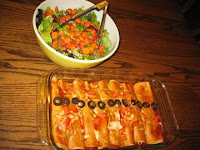A lot of kids grew up with Wonder Bread. It's dirt cheap (Walmart: 98 cents), but at least it has no hint of nutritional value. Nearly all of the bread at the supermarket is the same sort of nutritional wasteland. If you can find healthy bread at the store, it's gonna set you back $3-4 per loaf. This adds up when you've got at least five hungry hatchlings. I say "at least" because the neighborhood 'village' comes and goes through our house. We gave up counting long ago; we just feed whoever happens to be there at mealtime. We might be feeding someone else's kid the same day as one of our offspring is dining at some other household. It all probably works out in the end, and even if it doesn't, we're doing our part to feed the world.
 |
| Fresh and hot: it won't last long! |
The upshot of it all is that we go through a minimum of a loaf of bread every day. So for economy, health, and freshness (the Europeans quite properly show disdain for the American practice of bread stored in plastic for weeks rather than baked fresh daily as it ought to be), we have begun to bake our own bread. Do this completely by hand a few times, and you'll find out the knead that prompted the invention of bread machines. After we finished over-researching (it's a thing we do), we picked out a good one: the Zojirushi BBCC-X20 Home Bakery Supreme. It's got two paddles and bakes bread that actually looks like a loaf of bread, not some alien-looking bread cylinder that defies making a normal sandwich. Baking bread in the machine is easy and economical, but there's just something about hot, freshly baked bread that causes it to disappear with a rapidity that must be seen to be believed. Oh yes, and it makes a fantastic apple cake too.
What could be better--and better for you-- than freshly made whole wheat bread? Freshly ground whole wheat flour, that's what. We have a hand grinder in the basement that does double duty. For the obvious function it is second to none: it turns human power and whole wheat berries into fine flour suitable for baking. It is arguably even better for its other purpose: punishment. When the children transgress the rules of the house and civil society, there must be consequences; we don't want to raise bad citizens. Sending them to their room is ineffective at best. Sending the iPod on vacation for a day makes them wince, but it's not causing any remorse-inducing pain nor is it productive in any way (other than the fact that your child can actually hear you that day). But grinding seems to be the perfect solution.
Our household punishment usually takes the form of a stern look, a short(ish) lecture clarifying the wrong and proclaiming the right, and the finishing flourish: "Two cups." A major infraction (hitting in anger comes to mind) gets you four. And down you go, into the bowels of the house--the lonely basement where the grinder lives. It is there that our juvenile gladiators face off in physical combat with hard red winter wheat. Group offenders take turns grinding in a festive prisonyardlike exercise; solo offenders generally finish their work a whole lot faster because they are motivated by solitary confinement in a lonely basement to achieve early parole.
The end result of our efforts is a more peaceful household, children with well-developed upper arm muscles, and heaps upon heaps of freshly ground whole wheat flour. The bread we make then gives them the energy to invent new ways of exhibiting miscreant behavior. When we sense an infraction in progress, sometimes we even go so far as to taunt them: "Bring it on, short stuff: we need a couple more cups to make waffles tomorrow!"
What could be better--and better for you-- than freshly made whole wheat bread? Freshly ground whole wheat flour, that's what. We have a hand grinder in the basement that does double duty. For the obvious function it is second to none: it turns human power and whole wheat berries into fine flour suitable for baking. It is arguably even better for its other purpose: punishment. When the children transgress the rules of the house and civil society, there must be consequences; we don't want to raise bad citizens. Sending them to their room is ineffective at best. Sending the iPod on vacation for a day makes them wince, but it's not causing any remorse-inducing pain nor is it productive in any way (other than the fact that your child can actually hear you that day). But grinding seems to be the perfect solution.
Our household punishment usually takes the form of a stern look, a short(ish) lecture clarifying the wrong and proclaiming the right, and the finishing flourish: "Two cups." A major infraction (hitting in anger comes to mind) gets you four. And down you go, into the bowels of the house--the lonely basement where the grinder lives. It is there that our juvenile gladiators face off in physical combat with hard red winter wheat. Group offenders take turns grinding in a festive prisonyardlike exercise; solo offenders generally finish their work a whole lot faster because they are motivated by solitary confinement in a lonely basement to achieve early parole.
The end result of our efforts is a more peaceful household, children with well-developed upper arm muscles, and heaps upon heaps of freshly ground whole wheat flour. The bread we make then gives them the energy to invent new ways of exhibiting miscreant behavior. When we sense an infraction in progress, sometimes we even go so far as to taunt them: "Bring it on, short stuff: we need a couple more cups to make waffles tomorrow!"



